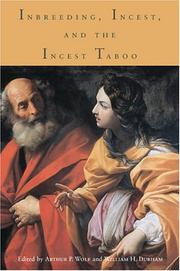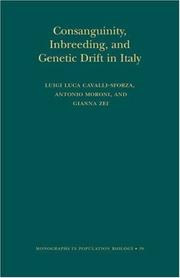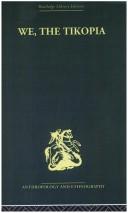| Listing 1 - 10 of 11 | << page >> |
Sort by
|
Book
Year: 2020 Publisher: Frontiers Media SA
Abstract | Keywords | Export | Availability | Bookmark
 Loading...
Loading...Choose an application
- Reference Manager
- EndNote
- RefWorks (Direct export to RefWorks)
This eBook is a collection of articles from a Frontiers Research Topic. Frontiers Research Topics are very popular trademarks of the Frontiers Journals Series: they are collections of at least ten articles, all centered on a particular subject. With their unique mix of varied contributions from Original Research to Review Articles, Frontiers Research Topics unify the most influential researchers, the latest key findings and historical advances in a hot research area! Find out more on how to host your own Frontiers Research Topic or contribute to one as an author by contacting the Frontiers Editorial Office: frontiersin.org/about/contact
Inbreeding --- Conservation --- Genetic diversity --- Effective population size --- Selection signature

ISBN: 0804767416 142371654X 9781423716549 9780804767415 080474596X 9780804745963 0804751412 9780804751414 Year: 2005 Publisher: Stanford, Calif. : Stanford University Press,
Abstract | Keywords | Export | Availability | Bookmark
 Loading...
Loading...Choose an application
- Reference Manager
- EndNote
- RefWorks (Direct export to RefWorks)
Is inbreeding harmful? Are human beings and other primates naturally inclined to mate with their closest relatives? Why is incest widely prohibited? Why does the scope of the prohibition vary from society to society? Why does incest occur despite the prohibition? What are the consequences? After one hundred years of intense argument, a broad consensus has emerged on the first two questions, but the debate over the others continues. That there is a biological basis for the avoidance of inbreeding seems incontrovertible, but just how injurious inbreeding really is for successive generations remains an open question. Nor has there been any conclusion to the debate over Freud’s view that the incest taboo is necessary because humans are sexually attracted to their closest relatives—a claim countered by Westermarck's argument for the sexually inhibiting effects of early childhood association. This book brings together contributions from the fields of genetics, behavioral biology, primatology, biological and social anthropology, philosophy, and psychiatry which reexamine these questions.
Incest. --- Consanguinity. --- Inbreeding. --- Taboo. --- Purity, Ritual --- Religion --- Sacrilege --- Breeding --- Consanguinity --- Marriage --- Heredity --- Inbreeding --- Incest --- Kinship --- Sex crimes --- Sexual intercourse --- Prohibited degrees --- Taboo
Book
Year: 2019 Publisher: Frontiers Media SA
Abstract | Keywords | Export | Availability | Bookmark
 Loading...
Loading...Choose an application
- Reference Manager
- EndNote
- RefWorks (Direct export to RefWorks)
This eBook is a collection of articles from a Frontiers Research Topic. Frontiers Research Topics are very popular trademarks of the Frontiers Journals Series: they are collections of at least ten articles, all centered on a particular subject. With their unique mix of varied contributions from Original Research to Review Articles, Frontiers Research Topics unify the most influential researchers, the latest key findings and historical advances in a hot research area! Find out more on how to host your own Frontiers Research Topic or contribute to one as an author by contacting the Frontiers Editorial Office: frontiersin.org/about/contact
Clonal growth --- environmental change --- epigenetics --- maternal effect --- transgenerational plasticity --- inbreeding plants

ISBN: 1299051537 1400847273 9781400847273 0691089914 9780691089911 0691089922 9780691089928 9781299051539 Year: 2004 Volume: 39 Publisher: Princeton, New Jersey : Princeton University Press,
Abstract | Keywords | Export | Availability | Bookmark
 Loading...
Loading...Choose an application
- Reference Manager
- EndNote
- RefWorks (Direct export to RefWorks)
In 1951, the geneticist Luigi Luca Cavalli-Sforza was teaching in Parma when a student--a priest named Antonio Moroni--told him about rich church records of demography and marriages between relatives. After convincing the Church to open its records, Cavalli-Sforza, Moroni, and Gianna Zei embarked on a landmark study that would last fifty years and cover all of Italy. This book assembles and analyzes the team's research for the first time. Using blood testing as well as church records, the team investigated the frequency of consanguineous marriages and its use for estimating inbreeding and studying the relations between inbreeding and drift. They tested the importance of random genetic drift by studying population structure through demography of the last three centuries, using it to predict the spatial variation of frequencies of genetic markers. The authors find that drift-related genetic variation, including its stabilization by migration, is best predicted by computer simulation. They also analyze the usefulness and limits of the concept of deme for defining Mendelian populations. The genetic effect of consanguineous marriage on recessive genetic diseases and for the detection of dominance in metric characters are also studied. Ultimately bringing together the many strands of their massive project, Cavalli-Sforza, Moroni, and Zei are able to map genetic drift in all of Italy's approximately 8,000 communes and to demonstrate the relationship between each locality's drift and various ecological and demographic factors. In terms of both methods and findings, their accomplishment is tremendously important for understanding human social structure and the genetic effects of drift and inbreeding.
Consanguinity --- Inbreeding --- Human population genetics --- Human genetics --- Genetic variation in humans --- Variation (Biology) --- Population genetics --- Breeding --- Marriage --- Heredity --- Incest --- Kinship --- Variation. --- Prohibited degrees --- Frieseke, Frederick Carl
Periodical
ISSN: 13447610 13473735 Year: 1994 Publisher: Tokyo: Japanese Society of Breeding,
Abstract | Keywords | Export | Availability | Bookmark
 Loading...
Loading...Choose an application
- Reference Manager
- EndNote
- RefWorks (Direct export to RefWorks)
Plant genetics. Plant evolution --- Breeding --- Plant breeding --- Amélioration génétique --- Plantes --- Periodicals --- Périodiques --- Amélioration --- Breeding. --- Agriculture Sciences --- Engineering --- Life Sciences --- Agricultural Biotechnology --- General and Others --- Plant Breeding --- Seed Technology & Propagation --- Biotechnology --- Selection, Artificial --- Breedings --- Genetics --- Inbreeding --- Breeding - Periodicals. --- Plant breeding - Periodicals.
Book
ISBN: 9781139423557 113942355X 1280682868 9781280682865 9781139015844 1139015842 9781139419468 1139419463 9781139421508 1139421506 9780521781862 0521781868 1139411160 1107225396 1139422480 9786613659804 113941741X 9781139411165 9781107225398 9781139422482 6613659800 Year: 2012 Publisher: Cambridge ; New York : Cambridge University Press,
Abstract | Keywords | Export | Availability | Bookmark
 Loading...
Loading...Choose an application
- Reference Manager
- EndNote
- RefWorks (Direct export to RefWorks)
An essential guide to this major contemporary issue, Consanguinity in Context is a uniquely comprehensive account of intra-familial marriage. Detailed information on past and present religious, social and legal practices and prohibitions is presented as a backdrop to the preferences and beliefs of the 1100+ million people in consanguineous unions. Chapters on population genetics, and the role of consanguinity in reproductive behaviour and genetic variation, set the scene for critical analyses of the influence of consanguinity on health in the early years of life. The discussion on consanguinity and disorders of adulthood is the first review of its kind and is particularly relevant given the ageing of the global population. Incest is treated as a separate issue, with historical and present-day examples examined. The final three chapters deal in detail with practical issues, including genetic testing, education and counselling, national and international legislation and imperatives, and the future of consanguineous marriage worldwide.
Consanguinity --- Consanguinity. --- Human population genetics. --- Incest --- Kinship. --- Ethnology --- Clans --- Families --- Kin recognition --- Sex crimes --- Sexual intercourse --- Human genetics --- Population genetics --- Marriage --- Heredity --- Inbreeding --- Kinship --- Health aspects. --- Psychological aspects. --- Prohibited degrees
Book
ISBN: 1608058883 1608058891 9781608058884 Year: 2014 Publisher: Sharjah, United Arab Emirates : Bentham Science Publishers,
Abstract | Keywords | Export | Availability | Bookmark
 Loading...
Loading...Choose an application
- Reference Manager
- EndNote
- RefWorks (Direct export to RefWorks)
Consanguineous marriages have been practiced for hundreds of years, predominantly by Moslems. Although it is generally accepted among communities that the social advantages outweigh other, the rate of congenital malformations and genetic diseases among the offspring borne of consanguineous marriages is higher and an increase in sterility, rates of abortions, stillbirths and neonatal deaths has been suggested by some researchers. These problems result in a substantial economic burden within the communities involved in the practice. Strategies for reducing the frequency of consanguineous marriag
Consanguinity. --- Genealogy. --- Ancestry --- Descent --- Family history (Genealogy) --- Family trees --- Genealogical research --- Genealogy --- Pedigrees --- Auxiliary sciences of history --- History --- Biography --- Heraldry --- Precedence --- Marriage --- Heredity --- Inbreeding --- Incest --- Kinship --- Methodology --- Research --- Prohibited degrees
Book
ISBN: 9535145010 9533072407 Year: 2011 Publisher: IntechOpen
Abstract | Keywords | Export | Availability | Bookmark
 Loading...
Loading...Choose an application
- Reference Manager
- EndNote
- RefWorks (Direct export to RefWorks)
The book Soybean: Molecular Aspects of Breeding focuses on recent progress in our understanding of the genetics and molecular biology of soybean and provides a broad review of the subject, from genome diversity to transformation and integration of desired genes using current technologies. This book is divided into four parts (Molecular Biology and Biotechnology, Breeding for Abiotic Stress, Breeding for Biotic Stress, Recent Technology) and contains 22 chapters.
Soybean. --- Breeding. --- Selection, Artificial --- Genetics --- Inbreeding --- Beer bean --- Dolichos soja --- Edamame --- Edible soybean --- Garden soybean --- Glycine gracilis --- Glycine hispida --- Glycine max --- Mao dou --- Phaseolus max --- Soja bean --- Soja hispida --- Soja max --- Soy-bean --- Soya --- Soya bean --- Soybean groundnut --- Sweet bean --- Vegetable soybean --- Beans --- Glycine (Plants) --- Life Sciences --- Biotechnology --- Genetics and Molecular Biology --- Bromatology --- Biochemistry

ISBN: 1136538011 1315017563 9781136538018 9781315017563 9781136538087 9781136538155 9780415330206 9780415511285 1136538089 0415511283 Year: 2004 Publisher: Oxon [England] ; New York : Routledge,
Abstract | Keywords | Export | Availability | Bookmark
 Loading...
Loading...Choose an application
- Reference Manager
- EndNote
- RefWorks (Direct export to RefWorks)
Recognized as a major work when first published, this title has, over the years, become a classic. Forming the basis of modern social anthropology, We the Tikiopia stands in the forefront of its literature.
The book is an excellent example of fieldwork analysis of a primitive society; a complete account of the working of a primitive kinship system; and an exhaustive and sophisticated study of Polynesian social institutions.
First published in 1936.
Tikopia (Solomon Islands people) --- Consanguinity. --- Families. --- Primitive societies. --- Man, Primitive --- Primitive society --- Society, Primitive --- Social evolution --- Family --- Families --- Family life --- Family relationships --- Family structure --- Relationships, Family --- Structure, Family --- Social institutions --- Birth order --- Domestic relations --- Home --- Households --- Kinship --- Marriage --- Matriarchy --- Parenthood --- Patriarchy --- Heredity --- Inbreeding --- Incest --- Tikopians --- Tucopia (Solomon Islands people) --- Ethnology --- Polynesians --- Social aspects --- Social conditions --- Prohibited degrees --- Primitive societies --- Consanguinity --- Social life and customs --- Tikopia (Solomon Islands people) - Social life and customs --- Kinship - Solomon Islands - Tikopia
Book
ISBN: 0674054148 9780674054141 0674035895 9780674035898 Year: 2009 Publisher: Cambridge, Mass. : Harvard University Press,
Abstract | Keywords | Export | Availability | Bookmark
 Loading...
Loading...Choose an application
- Reference Manager
- EndNote
- RefWorks (Direct export to RefWorks)
Like many gentlemen of his time, Charles Darwin married his first cousin. In fact, marriages between close relatives were commonplace in nineteenth-century England, and Adam Kuper argues that they played a crucial role in the rise of the bourgeoisie. This groundbreaking study brings out the connection between private lives, public fortunes, and the history of imperial Britain.
Consanguinity --- Cross-cousin marriage --- Incest --- Domestic relations --- Middle class --- Elite (Social sciences) --- Families --- Family law --- Marriage --- Persons (Law) --- Sex and law --- Sex crimes --- Sexual intercourse --- Cousin marriage --- Heredity --- Inbreeding --- Kinship --- Elites (Social sciences) --- Leadership --- Power (Social sciences) --- Social classes --- Social groups --- Bourgeoisie --- Commons (Social order) --- Middle classes --- History --- Social aspects --- Law and legislation --- Prohibited degrees --- Social conditions --- Histoire sociale --- --Grande-Bretagne --- --Bourgeoisie --- --History --- Consanguinity - England - History - 19th century. --- Cross-cousin marriage - England - History - 19th century. --- Incest - Social aspects - England - History - 19th century. --- Domestic relations - England - History - 19th century. --- Middle class - England - History - 19th century. --- Elite (Social sciences) - England - History - 19th century. --- Grande-Bretagne
| Listing 1 - 10 of 11 | << page >> |
Sort by
|

 Search
Search Feedback
Feedback About UniCat
About UniCat  Help
Help News
News